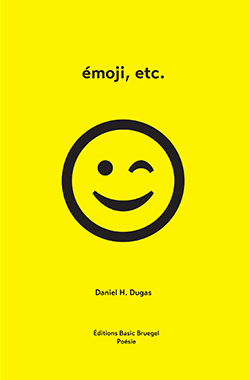Adieu Twitter. (2022)

Je suis triste d’avoir supprimé mon compte Twitter. J’étais sur la plateforme depuis 2009 et j’aimais beaucoup le format. Je me sens un peu orphelin ce soir, mais la venue d’Elon Musk a changé la donne. Plusieurs ont décidé de rester sur Twitter malgré la prise de contrôle, quelques-uns ont même déclaré qu’en restant ils résistaient à l’oppresseur. De mon côté, je pense que la venue d’un tel personnage, d’un égocentrisme qui rivalise avec celui de Trump, est dangereuse. Twitter est maintenant le jouet privé d’un grand malade et je ne veux en aucun cas m’associer et encourager ses lubies. D’autre part, c’était vraiment facile et très rapide d’effacer 13 ans de gazouillis.
I am sad to have deleted my Twitter account. I was on the platform since 2009 and I really liked the format. I feel orphaned tonight, but Elon Musk’s arrival changed the game. Many have decided to stay on Twitter despite the takeover. Some have cited that by staying, they are poised to participate in a kind of resistance to the oppressor. For my part, I think that the arrival of such a character, with an egocentricity that rivals Trump’s, is dangerous. Twitter is now the private plaything of a madman, and I don’t want to be associated with or encourage his whims in any way. On the other hand, it was really easy and quick to erase 13 years of tweets.
ABC: Art, Biodiversity and Condos (2022)
A recent article in the Toronto Star about a new mural installed in front of a luxury condo prompted me to reflect on art and biodiversity. My first reaction:

I admit I should have said celebrating instead of enhancing. I reread the article trying to make sense of it all, to remain open minded, and I tried to understand the motivations of both the artist and the developers. I cannot.
If biodiversity is the quality or state of having a large number of plant and animal species in an area, any new buildings that use that specific area, have direct impacts in terms of destruction of habitats and more subtle effects on biodiversity such as disturbance and fragmentation.[1]
There are many problems with the placement of this artwork. First, biodiversity and luxury condos don’t go hand in hand. There is a disjunction between the two even if the developers would like us to think otherwise. If biodiversity is for everyone, luxury condos are not. Moreover, there is a direct link between the loss of biodiversity and economic inequalities.[2] In other words, economic inequality predicts biodiversity loss. [3] I don’t know if a mural on the shady side of the building might remind us of flourishing biodiversity, or is it more likely a memento mori for it. Are we supposed to consider the biodiversity of Lake Ontario and its waterfront parks before or after the mural was put up?
The artist tells us that she was thinking of horizons, the way light reflects on water at different times of day and season. It’s too bad that the mural is facing the highway. The ones who have lakeside view apartments, would be more in tune to this than the ones who gaze inland. For those driving by, in the shadow of the building, it might be a wishful reminder that everything is excellent.
On the bright side, I am happy to read that the panels are recyclable, but it is a quality that remains obscure when we talk about permanent sculpture.
New condo celebrates lakefront biodiversity with 120-metre mural along the Gardiner (February 2, 2022)
[1] http://www.businessandbiodiversity.org/construction.html
[2] https://www.mcgill.ca/newsroom/channels/news/biodiversity-loss-linked-economic-inequality-worldwide-25398
[3] https://journals.plos.org/plosone/article?id=10.1371/journal.pone.0000444

February 7, 2022

February 8, 2022
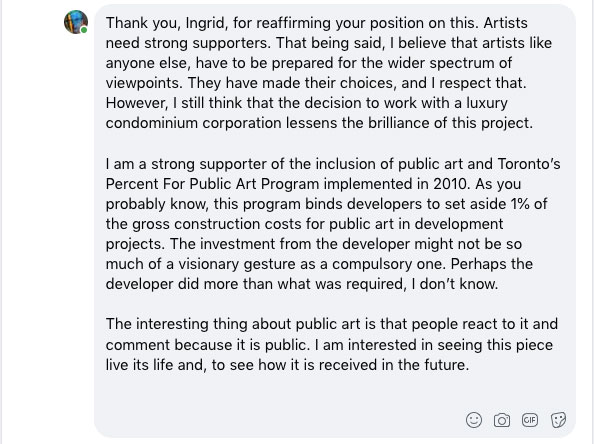
The secret life of logos or What do logos do after dark? (2021)

Logos are symbols or graphics meant to represent something, but how do they come to life? How are they imagined? Graphic designers look at the object to be logofy* and bring their own baggage to the drawing board, but often ideas from other brands become part, knowingly or not, of the new entity. These Frankensteinian objects have always fascinated me.
Recently, I was struck by the resemblance of the old Alberta College of Art and the Assomption-Vie logos. If the ACA logo, born I was told in the 1960s, is a brother or sister to the Penrose Triangle, the Assomption logo created in the mid-seventies, is certainly one of its cousins, but is also a descendent of the 1964 Woolmark Logo of the International Wool Textile Organisation.
‘Logofy’ in the same construction as in ‘Liquefy’.
Top left: Penrose Triangle, top right: Alberta College of Art, bottom left: Woolmark Logo and bottom right: Assomption-vie.
Thanks to Marion Garden, Alberta University of the Arts, and to Charles Cousins and Don Mabie for assistance in retracing the lineage of these logos.
Chariots (2021)
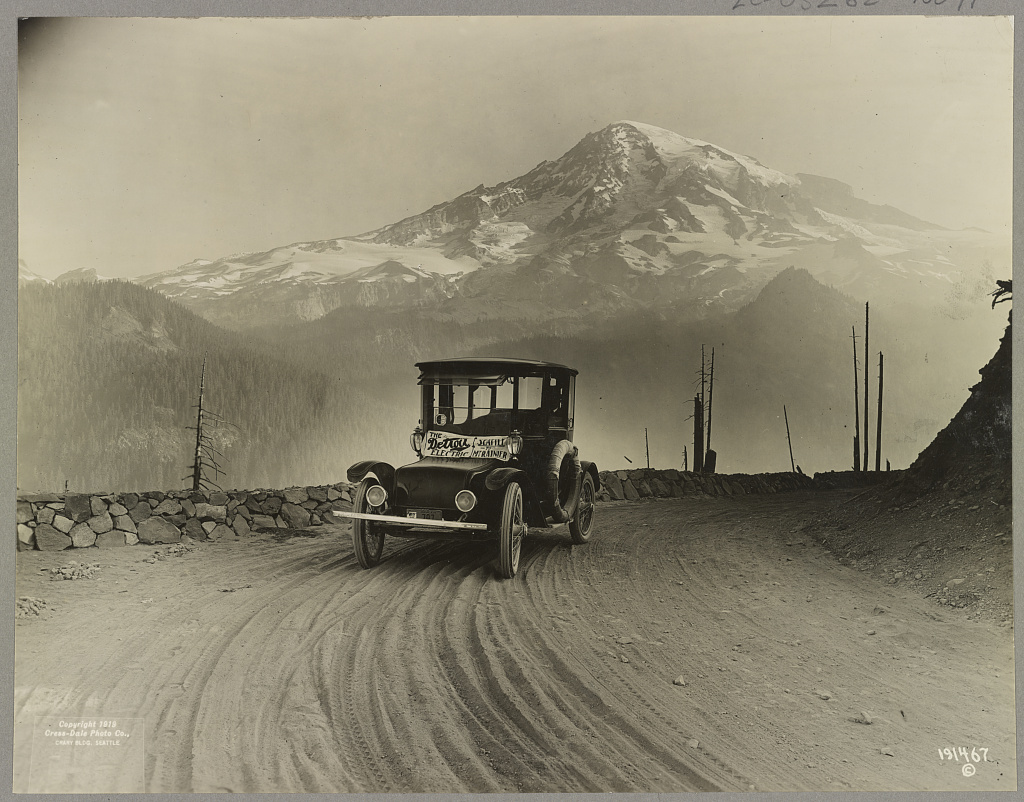
Clara Ford drove a 1914 Detroit Electric, which she by far preferred to the Model T, a gasoline engine car built by her husband Henry[1]. Detroit Electric shipped its last car in 1939 and now we are told that the race to the electric car has just started[2].
Every carmaker is planning to become carbon neutral soon, and they are telling us, constantly telling now, that the planet can only be saved by purchasing electric cars. Like anyone else, I can appreciate the advantage of eclectic cars in carbon management, but I feel that we are not given the whole story. According to some, BHP for example, there could be 125 million electric cars on the road by 2030. Each of these cars will need about 183 lbs. of copper to build their motors[3]. I am not sure that mining all of those millions of tons of copper will be very kind to Mother Earth. Will she be saved or not?
I also have a certain ‘inquiétude’, a worry that our planet can only be saved by those with money to promote the mining. How can the poor help? How can Earth be truly saved if we exclude those who are economically challenged? Is it not ‘our’ planet after all? How can the electric car be a symbol of both salvation and inequity? If there was a heartfelt desire to save Mother Earth, governments would give tax breaks to those who have forfeited car ownership, instead of helping others to buy more vehicles.
What is killing our world is the societal model of promoting constant and excessive consumption of all matter. The rest is marketing and, so far, marketing has not saved anything.
Daniel H. Dugas
February 23, 2021
Image credit: [Detroit Electric auto on a promotional tour through mountains from Seattle to Mt. Rainier] / Cress-Dale Photo Co., Crary Bldg, Seattle. https://www.loc.gov/item/2003653829/
For more on this:
A Clear Conscience and a Bright Blue Sky (2020)
http://daniel.basicbruegel.com/a-clear-conscience-and-a-bright-blue-sky-2020/
[1] Henry Ford’s Wife Wouldn’t Drive Ford Model T, Kept Her Electric Car
https://cleantechnica.com/2014/04/11/henry-fords-wife-wouldnt-drive-model-t-kept-electric-car/
[2] Our Path to an All-Electric Future
https://www.gm.com/electric-vehicles.html
[3] How Much Copper is in an Electric Vehicle?
https://www.visualcapitalist.com/how-much-copper-is-in-an-electric-vehicle/
A Clear Conscience and a Bright Blue Sky (2020)
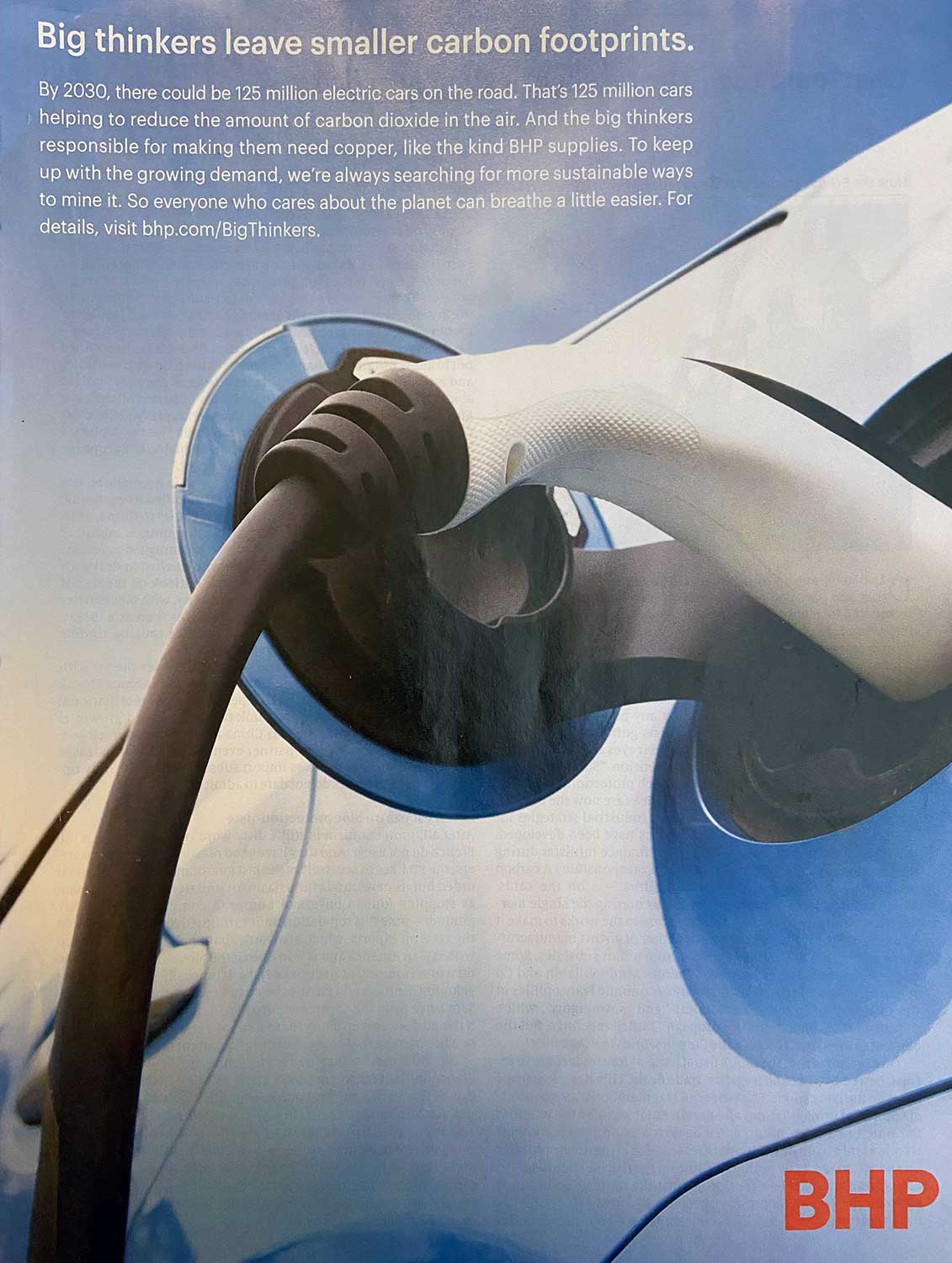
The goal of any ad is to make us feel good about a company and its products. This ad from the Melbourne, Australia-based BHP Billiton multinational mining, metals, and petroleum company, fits the bill. According to its advertorial gospel, published in The Economist October 2020, by reducing the amount of carbon dioxide in the air, electric cars will save the world. But this glossy hope does not tell the whole truth. The ad states that ‘by 2030, there could be 125 million electric cars on the road.’ More cars on the roads, this is the hope for our future and these are the words of a company responsible for so much destruction. Still fresh on our environmental awareness radar is the 2015 collapse of a dam at the Samarco-BHP mine. This was Brazil’s largest environmental disaster, it killed 19 people and spilled roughly 40 million cubic metres of toxic sludge into communities, the Rio Doce river, and the Atlantic Ocean, 650 km away[1]. BHP Billiton is also responsible for the Ok Tedi environmental disaster in Papua New Guinea. Between 1984 and 2013, BHP’s mine discharged about two billion tons of untreated mining waste into the Ok Tedi river[2]. This is the same company that has violated scores of indigenous communities’ rights across the Americas. The trail of environmental, social, and public health disasters linked to BHP[3] is a long one and yet they want us to think of them as the saviour of the world, they want us to believe that they are the ‘Big Thinkers’ who leave a small carbon footprint. It is hard to take and even harder to understand why such ads could be printed. One hundred and twenty-five million electric cars will not solve the problems of pollution that will occur through their manufacturing process; the extraction of tons and tons of copper needed to build the hearts and the veins of these cars will not make our planet better. The only ones to profit are the investors and perhaps the marketers selling us on the fallacy that our conscience should be clear.[4]
[1] BHP faces first step in $6.3 billion UK claim over Brazil dam failure
[2] Ok Tedi environmental disaster
[3] Broken Hills: Six cases from BHP’s long trail of disasters (PDF)
[4] According to the Visual Capitalist website, an EV contains about 183 lbs. of copper. 125 millions cars multiplied by 183 lbs. equal twenty three billion pounds of cooper.
From ‘Liberated Words’ (2020)
Re: Videopoetry / Vidéopoésie Interview with Catherine Parayre.
Sarah Tremlett posted the following text on the Liberated Words website:
BY SARAH TREMLETT · PUBLISHED OCTOBER 8, 2020
http://liberatedwords.com/2020/10/08/videopoetry-videopoesie-interview-with-catherine-parayre-2020/
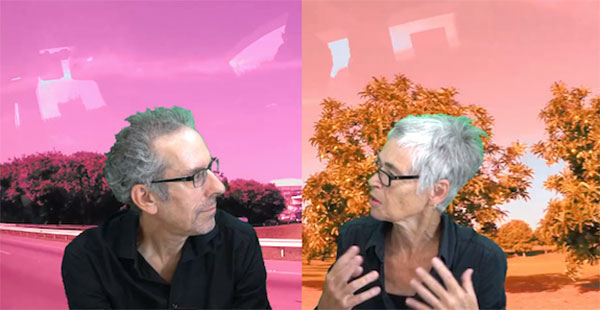
A while ago I mentioned the launch of the must-have publication on videopoetry ¬¬– Videopoetry / Videopoésie by pioneer Canadian practitioners Daniel H. Dugas and Valerie LeBlanc (Basic Bruegel). Valerie and Daniel have now conducted a really delightful, succinct and revealing interview see https://vimeo.com/447315272 with Catherine Parayre, editor at the book’s publishing house The Small Walker Press, Brock University, Ontario.
I am of course not impartial to their work since I was fortunate enough to be invited to write an essay for the book. In doing so I was able to excavate pure gold in terms of the history of videopoetry. This relatively short interview gives a glimpse into their world and how they work together. There are also some clever green screen projections and visually playful (I love the captioned birds behind them!) videos, which seem to have their own voice, almost stealing the thunder from their makers.
Some nuggets include their views on collaboration or shared vision: ‘when we witness the same events … reprocessing what we are seeing in different ways’; and their understanding of the term ‘videopoetry’ as opposed to referencing film, even though ‘the two are permeable today’. For them, they have always used video cameras (changing format across the decades) and worked with video as an accessible medium unlike film. Ultimately Daniel says he likes the term ‘video’ which comes from the Latin videre ‘to see’.
Catherine made a very poignant point about their video images; that though captured in a book, they seem to contain movement, as opposed to the still photograph. She emphasized that they weren’t ‘quite stable’. Daniel pointed out that often they were using older technology; or low grade consumer equipment that creates a ‘ghost’. But I feel there was more to that point, and I have noted how they work with time over and over again in their practice. This sense of passing through with video; the temporal philosophical estrangement of the moment, can become a rich metanarrative in the right hands. For Valerie and Daniel, time falters but does not stop.
Becoming Purse (2020)

A kid with a kite stands on the edge of a cliff. We cannot see her or his face; the natural lighting of the scene draws the figure as an iPod silhouette, anonymous and universal. There is something real in the image, like a snapshot taken from an outing; it could be your kid, my kid. The purple colour in the sky and the yellowish glow at the horizon point to a sunrise on the East coast or a sunset on the West coast. This is for anyone, anywhere, with leisure time. It might even be an ode to Homan Walsh, the youth who flew his kite high above the gorge of Niagara Falls in 1848. As a result, he was able to secure a line that was used to start the construction of the suspended bridge. At the bottom of this image, there is the caption ‘Imagination takes flight’.
But the reverie is interrupted when the physical intricacies kick in. If a cliff is a location able to provide ample wind, it might also be a dangerous place to hang out in the dark, whether it’s early in the morning or late in the evening. But falling is not the only hazard; another danger lurks just behind the child’s knees. Is it a line, a rod or is it part of the ribbon of the kite, we are not sure. Will the kid trip and tumble down the precipice? We hope not, but we don’t know. Maybe the kid falls onto the rocks below, but ultimately the flying kite saves him? Maybe.
‘Go fly a kite’ is a phrase that is used to tell someone to ‘get lost’. The kid seems to be alone, but someone took the picture, so it is not the case. ‘As high as a kite,’ is an expression to indicate that someone is extremely intoxicated. Although a video would be a better way to gauge the situation, there is no evidence that the kid or the photographer is high. Louis Vuitton is inviting us to be part of a kite experiment, but we are not as yet sure what the circumstances of this flight of imagination might be.
A kite needs a tail to keep it from spinning and rolling around. The one in the picture has a long tail and will probably be stable. In French, the word tail (queue) has the same meaning as the English word, but it can also mean a penis. To me, the small protruding part on the left side of the ribbon looks like the French descriptor. And if we take the bottom section of the tail (which looks like a ‘skydancer’ or ‘tube man’ and is about the same height as the kid) and moved it to the right, juxtaposing it onto the child, we can see an appendage appear: the kid becomes a man!
And then other symbolism gets in the way: two crosses floating in mid-air. What are they? The first one is part of the frame of the kite; the second, made of ribbon, floats above and is out of focus. The latter takes the appearance of a double helix. The kid is a believer, a man of science now dabbling in molecular biology!
We don’t know what kind of kite experiment is at play here. Is it a religious or a biological quest, or is it just family fun in search of the perfect ‘sacoche’? How can this image of a kid becoming man, and a kite with religious undertones, make us feel toward a leather purse is anyone’s guess. The imagination can only hover so long above the abyss of the dreamed object. If a heavy purse makes the heart light, it can also weigh down the kite.



The value of ours lives (2020)
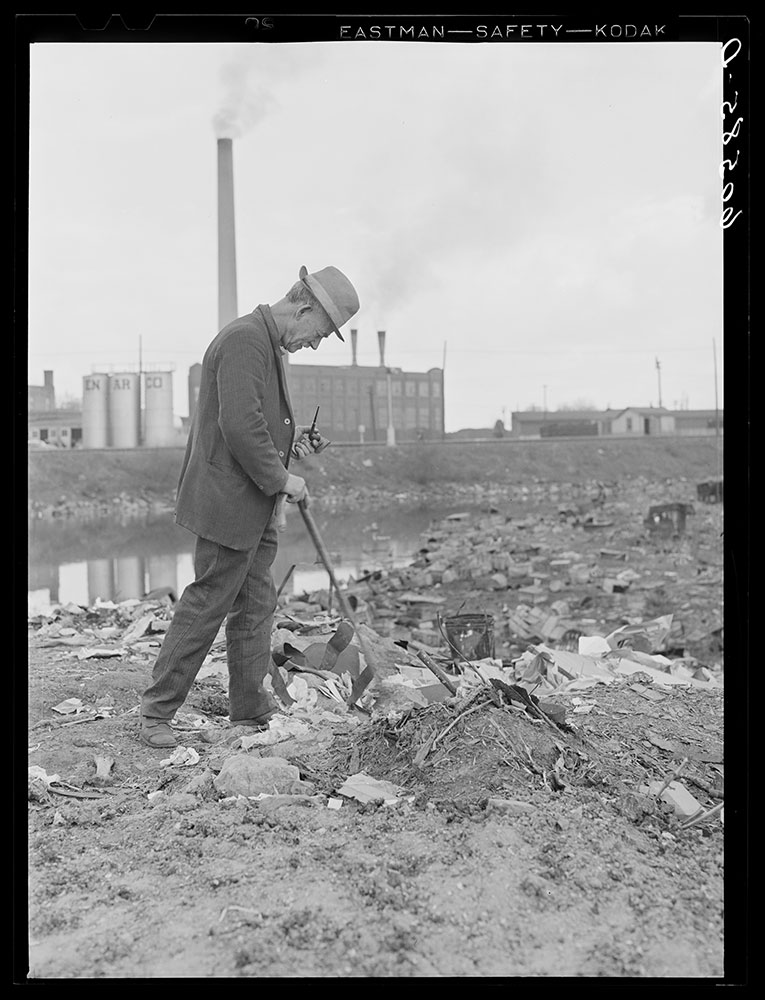
The Covid-19 pandemic has given us a chance to know what our leaders think of the value of ours lives. If this isn’t cool, it is at least interesting.
Yes, life is complicated and we know, priceless. Nevertheless, there are methods to assess the value of a life, which is also a complicated thing to do. Different economists will come up with different results. It all depends on the angle that is chosen. Two basic and often quoted methods to monetize and estimate the value of a life are the VSL (value of statistical life) and the QALY (value of a quality-adjusted life-year). In the U.S., the Office of Management and Budget puts the value of a human life in the range of $7 to $9 million. We can assume that the numbers in Canada are near those of the US. As we also know how much money the governments have thrown at the coronavirus crisis so far, we should be able to calculate how far our societies will go to preserve life or decide to let some go.
The whole situation is a conundrum at best or a Hobson Choice at worst: we live next to a factory that spews toxins over our communities, but that is where we work.
See also: The Cost of a Human Life, Statistically Speaking
Photo, Library of Congress: Residents of shack town making daily round through the city dump looking for anything of value. Dubuque, Iowa | Vachon, John, 1914-1975, photographer
Your Life Is Worth $10 Million, According To The Government
NPR, July 17, 20208:01 AM ET
https://www.npr.org/sections/money/2020/07/17/870483369/your-life-is-worth-10-million-according-to-the-government
Videopoetry / Vidéopoésie announcement Liberated Words (2020)
Videopoetry = Vidéopoésie
BY · PUBLISHED · UPDATED
Wonderful news that the mammoth – over 400 pages – publication Videopoetry = Vidéopoésie by leading Canadian videopoets Valerie LeBlanc and Daniel H. Dugas is now out online https://dr.library.brocku.ca/handle/10464/14790
Published by Brock University’s Small Walker Press it is a comprehensive survey of their collaboration over a thirty-year period. Catherine Parayre has written the French introduction, with Lucy English writing in English. It has also been my pleasure to contribute an essay on their extraordinary body of work. In my research it took me a long time to get to know (and relish) all their developments. I am particularly fond of their use of documenting first-hand experience as in ‘Slices of Life’ from the nineties for example; as well as their finely crafted and important ecopoetry films of more recent years. For my in-depth analysis on their filmic and poetic techniques please check out the book itself.
But I would just like to say that what adds to the poetry (that is always succinct, and of its time and place whilst setting us on a philosophical path), is the fact that it is bilingual. This can create comparisons (visual as well as verbal), as one language is typeset next to the other, but also reminds us of their Canadian roots, and all its associations and influences (geographic, artistic and political). The poetry and the videos emanate not just from the combining of two creative fields, and the collaboration and consequent creative marriage of two people, but two significant cultures. This ‘bilinguality’ extends our understanding of what it means to be not just poetically engaged and enlightened but politically aware in the 21st century. Go Read!!!!
Starboard (2019)

Keywords: ecocide, whales, society, conscience
The Japanese government lifts the whaling ban and kills two the first day. That is the headline we all woke up to hear. For me, it was like reading that we were at war, that an earthquake had struck, that a bomb had exploded.
How can we consciously decide to get out to slaughter the few whales that are left in the oceans? And for what? How can we do this after having been exposed to all of the awareness campaigns of the last 30 years? After having seen all of the whale movies? Was it all just entertainment, good old fun? Today our conscience is more akin to bling, something that we wear if it matches the rest of our outfit. It seems that we are not capable of becoming aware of any moral principles, incapable of being motivated to act upon them and that we cannot assess our character, our behavior, and ultimately ourselves against those principles. [1] We are the spect-actors of a horrible spectacle, but we still enjoy the drama.
Everything that we have seen and everything that we have believed in is as useless as the trash blowing on a street. Worse, we are the ones throwing the refuse out of the car windows while driving on a scenic route. I am ashamed to be part of it. Yes, I am part of it, we all are. At this moment, we are putting our raincoats and sharpening our harpoons. We are leaving our homes under the cheers of our friends and families. We are going to bring back as many whales as we can. The world has made us monsters roaming the seas, death is our trophy.
And right here, at the antipode of these Japanese killing fields, in our own Gulf of St. Lawrence, scores of whales wash onshore, entangled, hit, rotting. At first, we see a stand-to from the government, imposing a speed limit on vessels in the Gulf. It didn’t take long to hear protests from the shipping, the cruise lines, and the fishing industries. Our vacations, our consumption, and our infinite appetite for seafood are what count here. It is all complicated, they say. For our economy, etc. It has come down to this: to us, wanting things and not giving a damn about anything else. Making payments on a fully loaded F-150 has more value than saving a whale. And our subsequent collective silence is a collective nod to kill the last of every living thing. We are like those who are directly involved, those putting on raincoats and sharpening harpoons.
When the last whale alive will near the end of its life, entrepreneurs will surely seize the opportunity to create an event where seats will be sold and snacks will be served. The chosen few will witness the extinction of that great animal. It will become a handle, a hashtag, an image on Instagram, as it vanishes from our world.
The sea is rough and my shame and my sadness have no weight to hold it back. I am on a dingy, struggling to float beside the larger ships of our modern life.
P.S. A few years ago, the International Criminal Court was considering adding Ecocide to its list of punishable crimes [2]. I am sure that whaling falls into this category.
[1] Conscience, paraphrased from the Stanford Encyclopedia of Philosophy, Mar 14, 2016
https://plato.stanford.edu/entries/conscience/
[2] Proposed amendment to the Rome Statute, Eradicating Ecocide
https://eradicatingecocide.com/the-law/what-is-ecocide/
Image: Cutting up a blue whale | Library of Congress https://www.loc.gov/item/99614373/
Daniel H. Dugas
Archives
Blogroll
- A.I.R. Vallauris
- ACAD
- Adobe additional services
- Adobe Creative Cloud
- AIRIE
- Amaas
- Amazon Author Central
- ARTothèque
- Australian Poetry
- Basic Bruegel
- Bitly
- CCCA
- CDBaby
- Cycling 74
- Dissolution
- Éditions Prise de parole
- Emmedia
- eyelevelgallery
- FAVA
- Festival acadien de poésie
- Festival FRYE Festival
- FILE – Electronic Language International Festival
- Freeware list
- Fringe Online
- Galerie Sans Nom
- Gotta Minute Film Festival
- Instants Vidéo
- JUiCYHEADS
- Kindle Direct Publishing
- Klondike Institute of Art and Culture
- La Maison de la poésie de Montréal
- La Maison de la Poésie et de la Langue française Wallonie-Bruxelles
- Laboratorio Arte-Alameda
- Le Centre Jacques Cartier
- Liberated Words
- Maison Internationale de la Poésie – Arthur Haulot
- MediaPackBoard
- Miami Book Fair International
- Monoskop
- Mot Dit
- NSCAD University
- Paved Arts
- PoetryFilm
- Portail des auteurs du Nouveau-Brunswick
- RECF
- Revue Ancrages
- Salon du Livre du Grand Sudbury
- Sculpture Space
- Subtropics.org
- Sydney college for the arts
- The Centre for Contemporary Canadian Art
- The New Gallery
- Trevigliopoesia
- tumbler-documents
- V Tape
- Valerie LeBlanc
- VideoBardo
- Void Network-Κενο Δίκτυο
Categories
- #covidpoèmes
- Advertisement
- AIRIE
- Ancrages
- anthology
- Anthropocene
- Architecture
- Around Osprey
- art
- Article de presse
- arts visuels
- audio
- Australian Poetry
- Basic Bruegel Editions
- Book
- book fair
- Cafe Poet Program
- Ce qu'on emporte avec nous
- Citations gratuites
- Collaboration
- commentaire
- commentary
- Compte rendu
- conférence
- Conservation Foundation of the Gulf Coast
- COVID-19
- Critique littéraire
- culture
- Daniel Dugas
- Design
- Édition Michel-Henri
- Éditions Perce-Neige
- Éloizes
- Emmedia
- emoji etc | émoji etc
- Environnement
- essai
- essay
- Everglades
- Exhibition
- festival
- Festival acadien de poésie
- Festival Frye Festival
- FIPTR
- Flow: Big Waters
- Fundy
- Habitat
- installation
- Instants Vidéo
- interactivity
- journal
- JUiCYHEADS
- Kisii
- L'Esprit du temps
- laptop
- Leaving São Paulo
- lecture
- Livre
- logos
- Magazine
- Miami Book Fair
- Moncton 24
- novel
- OASIS
- oil spill
- perception
- performance
- Photo
- poésie
- Poetic Licence Week
- Poetry
- politics
- politique
- press
- Prise de parole
- Revue Ancrages
- salon du livre
- sculpture
- Sculpture Space
- sound
- Souvenirs
- Spirit of the Time
- Style & Artifacts
- Symposium d'art/nature
- talk
- television
- The New Gallery
- Uncategorized
- Valerie LeBlanc
- vidéo
- vidéopoésie
- Videopoetr/Vidéopoésie
- videopoetry
- visual arts
- What We Take With Us
- youth literature






